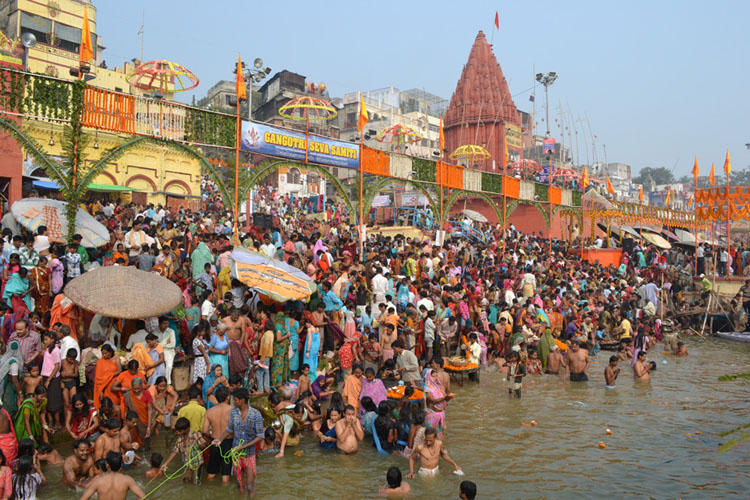Kartik Poornima
Kartika Poornima (Kartika purnima) is the Hindu, Jain and Sikh holy festival, celebrated on the Purnima (full moon) day or the fifteenth lunar day of Kartika (November–December). It is also known as Tripuri Poornima and Tripurari Poornima. It is sometimes called Deva-Diwali or Deva-Deepawali - the festival of lights of the gods.
Significance in Hinduism
Hindus celebrate it as a day when God incarnated himself as 'Matsya' or Fish. Vishnu took the Fish Incarnation to save Vaivasvata, the seventh Manu and the progenitor of the human race from the Deluge.
Lord Mahadev killed a demon named Tripuri on this day and hence, it is known as Tripuri Purnima. Kartik Purnima has immense religious value according to the Hindu mythology. There is a tradition of taking a bath in Ganga and donating lamps on this day. It is believed that Kartik Purnima provides Dharma, Artha, Kama and Salvation.
Kartik Purnima is considered as an auspicious day according to Hindu mythology. It is considered to be day of Lord Shiva, Lord Brahma, Lord Vishnu, Lord Angira and Lord Sun. A person involving in baths, charity, and donation etc on this day receives fruitful results. Shri Satyanarayana story is read on this day and lamps are lit on intersections, under Peepal trees, in temples etc. Prayers offered on each Purnima beginning from Kartik Purnima give positive results.
Significance in Jainism:
Kartik Poornima is an important religious day for Jains who celebrate it by visiting Palitana a Jain pilgrimage centre.Thousands of Jain pilgrims flock to the foothills of Shatrunjay hills of Palitana taluka on the day of Kartik Poornima to undertake the auspicious yatra (journey). Also known as the Shri Shantrunjay Teerth Yatra, this walk is an important religious event in the life of a Jain devotee, who covers 216 km of rough mountainous terrain on foot to worship at the Lord Adinath temple atop the hill.
Considered to be a very auspicious day for Jains, the day also assumes more significance for the walk, as the hills, which are closed to the public during the four months of Chaturmas, are thrown open for the devotees on Kartik Poornima. The day of Kartik Poornima is very significant in Jainism.
Significance in Sikhism:
For Sikhs, too, the day of Kartik Poornima is very auspicious, as it coincides with their festival of Guru Nanak Jayanti (Guru Nanak Gurpurab). The founder of their religion, Guru Nanak was born on the day of Kartik Poornima in 1469 AD. Apart from Sikhs, the Nanakpanthi Hindus and other followers of Guru Nanak's philosophy also celebrate this festival.
Significance in Hinduism
Hindus celebrate it as a day when God incarnated himself as 'Matsya' or Fish. Vishnu took the Fish Incarnation to save Vaivasvata, the seventh Manu and the progenitor of the human race from the Deluge.
Lord Mahadev killed a demon named Tripuri on this day and hence, it is known as Tripuri Purnima. Kartik Purnima has immense religious value according to the Hindu mythology. There is a tradition of taking a bath in Ganga and donating lamps on this day. It is believed that Kartik Purnima provides Dharma, Artha, Kama and Salvation.
Kartik Purnima is considered as an auspicious day according to Hindu mythology. It is considered to be day of Lord Shiva, Lord Brahma, Lord Vishnu, Lord Angira and Lord Sun. A person involving in baths, charity, and donation etc on this day receives fruitful results. Shri Satyanarayana story is read on this day and lamps are lit on intersections, under Peepal trees, in temples etc. Prayers offered on each Purnima beginning from Kartik Purnima give positive results.
Significance in Jainism:
Kartik Poornima is an important religious day for Jains who celebrate it by visiting Palitana a Jain pilgrimage centre.Thousands of Jain pilgrims flock to the foothills of Shatrunjay hills of Palitana taluka on the day of Kartik Poornima to undertake the auspicious yatra (journey). Also known as the Shri Shantrunjay Teerth Yatra, this walk is an important religious event in the life of a Jain devotee, who covers 216 km of rough mountainous terrain on foot to worship at the Lord Adinath temple atop the hill.
Considered to be a very auspicious day for Jains, the day also assumes more significance for the walk, as the hills, which are closed to the public during the four months of Chaturmas, are thrown open for the devotees on Kartik Poornima. The day of Kartik Poornima is very significant in Jainism.
Significance in Sikhism:
For Sikhs, too, the day of Kartik Poornima is very auspicious, as it coincides with their festival of Guru Nanak Jayanti (Guru Nanak Gurpurab). The founder of their religion, Guru Nanak was born on the day of Kartik Poornima in 1469 AD. Apart from Sikhs, the Nanakpanthi Hindus and other followers of Guru Nanak's philosophy also celebrate this festival.



